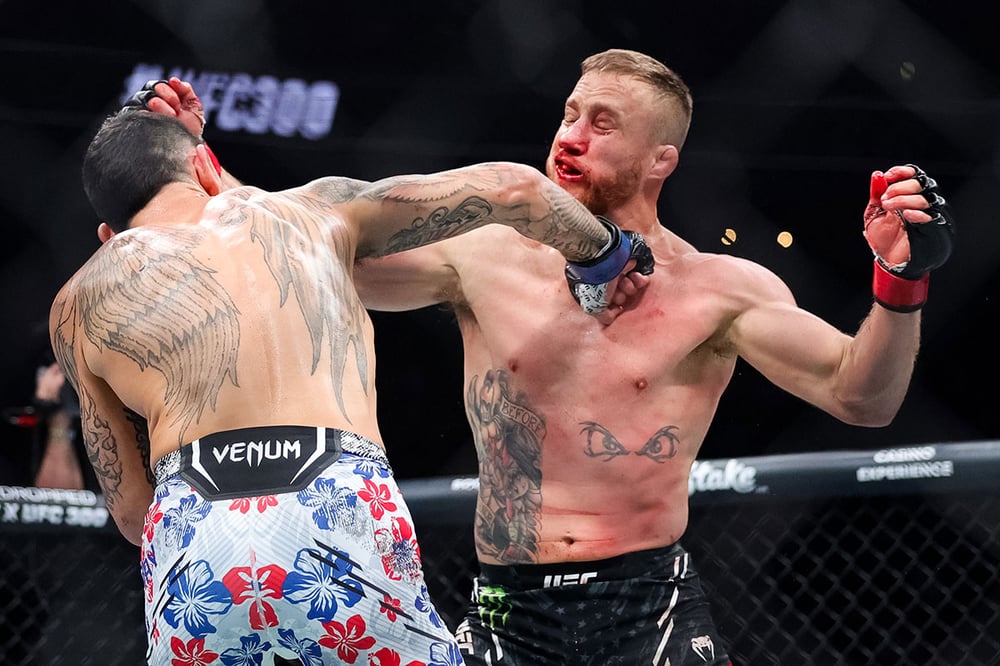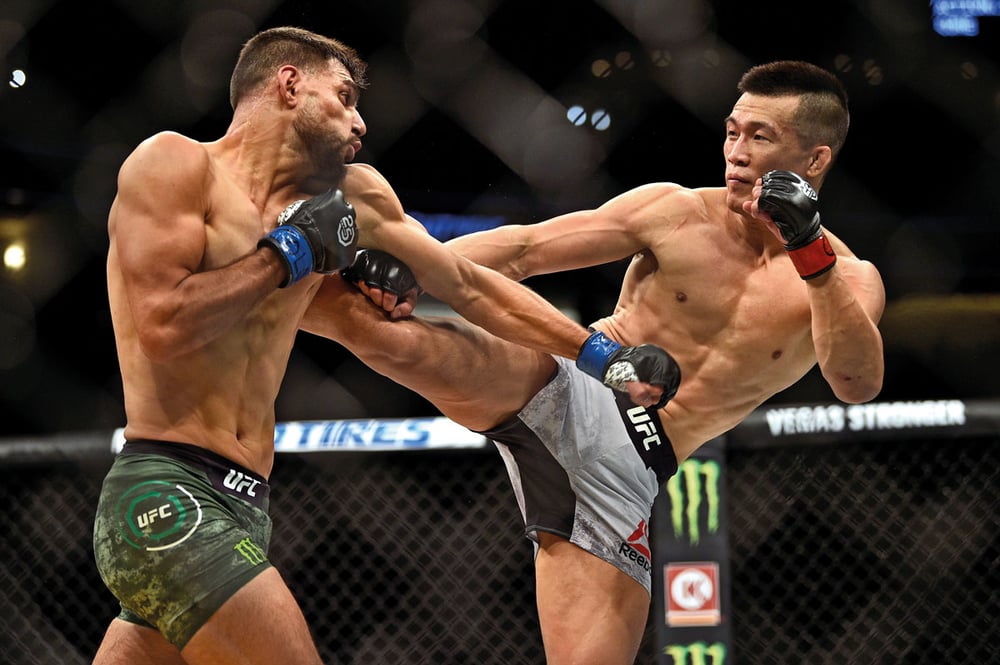
Issue 204
April 2024
Fighters who relentlessly advance offer a declaration of intent because advancing isn’t just movement - it’s a statement. But does it work? Ray Klerck unpacks this calculated tactic to discover how controlling the pace leads to victory.
It’s a treat watching a fighter push forward like a T-800, bringing an unstoppable force that turns a bout into Judgment Day. It’s not just about physical dominance; it's a strategy that offers insight into their thirst for victory. The fighters who embody relentless aggression do more than push forward—they dictate the rhythm of the fight, controlling the space and pace to force their game plan. This approach, favored by the likes of greats like Cormier, Holloway, and Nurmagomedov, transforms the octagon into a tactical battle where every step forward is a calculated move in a high-stakes chess match. This relentless forward motion isn't just effective—it generates a spectacle that firehoses dopamine into the brain of every fight fan. Sure, moving forward is well-worn territory, but if you want it fed to you like peeled grapes to a Roman emperor, then here’s what makes up the layers of this aggressive style, exploring what drives fighters to adopt this high-risk, high-reward strategy and how it shapes the outcomes of their matchups.

THE PSYCHOLOGY OF PRESSURE FIGHTING
What’s going on in the cerebral circus of a fighter who is always moving forward? Well, the choice about whether to advance or retreat is not merely tactical but deeply psychological. Insights from a systematic review in the European Journal of Investigation in Health, Psychology and Education shed light on the mindset that may influence a fighter's decision to fight in this style. This comprehensive review emphasizes that psychological constructs such as confidence, mental toughness, mood, and motivation play crucial roles in a fighter's performance. A fighter with serious mental toughness and titanium confidence might be more inclined to move forward, attempting to dominate the opponent and control the pace of the fight.
This review notes that mood states affected by upcoming fights can alter aggression levels, which might encourage a more aggressive and forward-moving style. Motivations, too, are pivotal. Fighters driven by desires for supremacy or demonstrating skill might use this forward-moving approach as a manifestation of their inner gray matter. These factors underscore the complexity of fight strategies, suggesting that the decision to move forward is not just a physical tactic but also a reflection of the fighter's psychological preparation and resilience. When we watch them, it feels as if they’re clenching their jaws around the fight it like a terrier with a rat, who want to shake until its spine snaps, then tear its belly open from anus to throat until the entrails drip from their chin. Whether this mindset wins more fights isn’t clear, but the tactical advantages, such as octagon control and dominance, certainly give you something to root for.
DOES MOVING FORWARD PUT YOU MORE AT RISK?
If this tactic were a recipe for victory, every fighter would do it. You probably know the story, but if you need to rake the pile of ashes again, Ronda Rousey found out against Holly Holm. Aldo got clipped after coming forward against McGregor. And so, the list of broken dreams continues.

Training to adopt this style focuses on several key areas: cardiovascular endurance, mental resilience, and tactical aggression. Anyone who wants to adopt this tactic must undergo rigorous sparring sessions that mimic the relentless pace of a real fight, conditioning them to manage adrenaline, fear, and fatigue. Coaches also instil a deep understanding of energy management, ensuring fighters know when to explode and conserve, turning relentless aggression into a sustainable fight plan. The forward-moving fight style has plenty of risks. Physically, fighters expose themselves to significant strikes as they close the distance, and the high pace can lead to quicker fatigue. However, the rewards can be substantial.
While potentially beneficial for controlling the fight and applying pressure, it also introduces certain risks that can impact a fighter's performance and safety. Insights from the systematic review in the European Journal of Health, Psychology, and Education provide a well-rounded perspective on these risks.
Firstly, the mental toll of aggressive tactics can be significant. The research highlights that a fighter anticipating a tough fight experienced increased tension and anger. While potentially fuelling aggression and forward movement, this heightened emotional state may also impair judgment or control during a fight. The risk here is that overly aggressive fighters might expose themselves to counterattacks, especially if their forward movement becomes predictable or uncontrolled.
Additionally, the review mentions the psychological strain related to fear of injury or defeat, which aggressive tactics can aggravate. The fear and stress associated with moving forward and engaging closely with the opponent might affect a fighter's mental state, potentially leading to hesitation or mistakes. Fighters who can manage their fears and maintain solid mental focus generally perform better, indicating that effectively managing the psychological risks of aggressive forward movement is crucial.
The review also touches on the physical risks associated with forward-moving tactics. Engaging directly and frequently can increase the likelihood of being on the receiving end of significant strikes, contributing to the physical toll on fighters, which might affect not only the outcome of the current fight but also a fighter's longevity in the sport.
From a tactical standpoint, while forward movement and aggression can be beneficial and often lead to controlling the pace and position of the fight, they require a balance with defensive skills to mitigate these risks. Fighters must develop a robust psychological toolkit—including confidence, mental toughness, and mood regulation strategies—to effectively manage this aggressive approach's inherent dangers.
What does this mean? The narrative constructed from these studies emphasizes that while moving forward in MMA can increase a fighter's chances of winning by demonstrating aggression and control, it also requires careful management of psychological and physical risks to ensure overall effectiveness and safety.
FIGHTERS WHO ONLY KNOW ONE WAY
Justin Gaethje: The Human Highlight Reel’s approach to fighting embodies violence and spectacle. His willingness to exchange heavy blows comes from a deep-seated belief in the power of his hands and chin, trusting that he will be the last man standing. It works, mostly, unless faced with a Holloway.
Paddy Pimblett: Emerging from the vibrant fight scene in Liverpool, Pimblett brings a blend of bravado and skill that makes his forward pressure entertaining. His approach reflects his charismatic personality, making every fight a statement.
Max Holloway: Known for setting records with his striking volume, Holloway uses pressure as a chess move. He overwhelms opponents with pace and volume, tactically breaking them down over time and showing that pressure can be both a physical and psychological tool.
Korean Zombie (Chan Sung Jung): Chan Sung Jung's ability to absorb damage and continue pressing forward made him a fan favorite. His fights are wars of attrition, where he often emerges as the embodiment of his moniker, showcasing an almost supernatural ability to keep moving forward.
Khabib Nurmagomedov: Khabib's style of pressure wasn’t just about physical dominance but psychological warfare. By smothering his opponents with his wrestling, he imposed a sense of inevitability, breaking their will as much as their physical ability to compete. Most of all, he talked constantly, telling them they had no choice but to give up.

FAN FAVORITES
Fighters embracing this style are the favorites of sports fans of every pronoun. They often push big social media numbers and achieve memorable knockouts, securing bonuses and headline spots. They embody the fighter’s spirit, earning respect and admiration from fans and peers alike.
Relentlessly moving forward illustrates MMA's core appeal: the confrontation of fear, the triumph over pain, and the relentless pursuit of victory. Fighters who adopt this tactic are not just participants in their bouts but protagonists in a dramatic battle of wills. There's a visceral thrill in watching a fighter who refuses to back down, who meets every challenge head-on. This fighting style taps into combat sports' raw and emotional core to offer a straightforward narrative of courage and determination that resonates deeply with audiences. They inspire us by embodying the resilience at the heart of every human struggle. As MMA continues to evolve, the influence of these warriors ensures that the spirit of the fight will forever be linked not just to the strategy but to the soul of what it means to compete.










